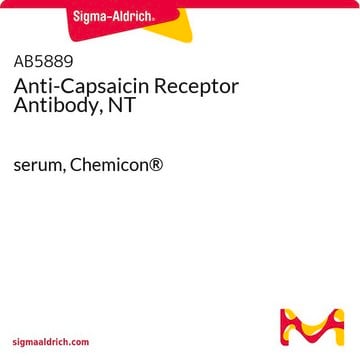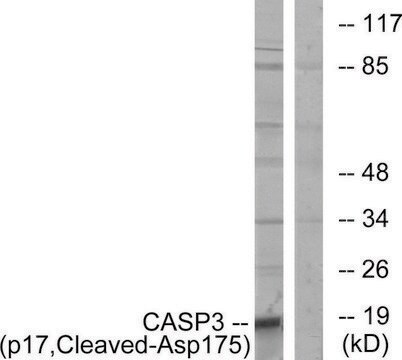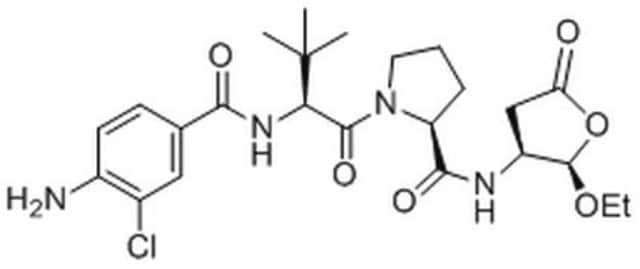400011
Caspase-1 Inhibitor I, Cell-Permeable
The Caspase-1 Inhibitor I, Cell-Permeable controls the biological activity of Caspase-1. This small molecule/inhibitor is primarily used for Cancer applications.
Synonym(s):
Caspase-1 Inhibitor I, Cell-Permeable, ICE Inhibitor I, Cell-permeable, YVAD-CHO, Cell-permeable, Ac-AAVALLPAVLLALLAPYVAD-CHO
Sign Into View Organizational & Contract Pricing
All Photos(1)
About This Item
Empirical Formula (Hill Notation):
C97H160N20O24
Molecular Weight:
1990.43
UNSPSC Code:
12352200
NACRES:
NA.77
Recommended Products
Quality Level
Assay
≥97% (HPLC)
form
solid
potency
1 nM Ki
manufacturer/tradename
Calbiochem®
storage condition
OK to freeze
color
white
solubility
DMSO: 5 mg/mL
shipped in
ambient
storage temp.
−20°C
General description
A cell-permeable inhibitor of caspase-1 (ICE; Interleukin-1β Converting Enzyme), caspase-4, and caspase-5. The C-terminal YVAD-CHO sequence of this peptide is a highly specific, potent, and reversible inhibitor of caspase-1 (Ki = 1 nM). The N-terminal sequence (amino acid residues 1-16) corresponds to the hydrophobic region (h-region) of the signal peptide of the Kaposi fibroblast growth factor (K-FGF) and confers cell-permeability to the peptide.
A cell-permeable inhibitor of caspase-1 (ICE; interleukin-1β converting enzyme). The C-terminal YVAD-CHO sequence of this peptide is a highly specific, potent, and reversible inhibitor of caspase-1 (Ki = 1 nM). The N-terminal sequence (residues 1-16) corresponds to the hydrophobic region (h-region) of the signal peptide of Kaposi fibroblast growth factor (K-FGF) and confers cell-permeability to the peptide.
Biochem/physiol Actions
Cell permeable: yes
Primary Target
Caspase-1
Caspase-1
Product does not compete with ATP.
Reversible: yes
Warning
Toxicity: Standard Handling (A)
Sequence
Ac-Ala-Ala-Val-Ala-Leu-Leu-Pro-Ala-Val-Leu-Leu-Ala-Leu-Leu-Ala-Pro-Tyr-Val-Ala-Asp-CHO
Reconstitution
Following reconstitution aliquot and freeze (-20°C). Stock solutions are stable for up to 1 month at -20°C.
Other Notes
Garcia-Calvo, M., et al. 1998. J. Biol. Chem. 273, 32608.
Hilbi, H., et al. 1998. J. Biol. Chem. 273, 32895.
Thornberry, N.A., and Lazebnik, Y. 1998. Science 281, 1312.
Lin, Y.-Z., et al. 1996. J. Biol. Chem.271, 5305.
Lin, Y.-Z., et al. 1995. J. Biol. Chem.270, 14255.
Reiter, L.A. 1994. Int. J. Pept. Protein Res.43, 87.
Thornberry, N.A., et al. 1994. Biochemistry33, 3934.
Thornberry, N.A., et al. 1994. MethodsEnzymol. 244, 615.
Thornberry, N.A., et al. 1992. Nature 356, 768.
Hilbi, H., et al. 1998. J. Biol. Chem. 273, 32895.
Thornberry, N.A., and Lazebnik, Y. 1998. Science 281, 1312.
Lin, Y.-Z., et al. 1996. J. Biol. Chem.271, 5305.
Lin, Y.-Z., et al. 1995. J. Biol. Chem.270, 14255.
Reiter, L.A. 1994. Int. J. Pept. Protein Res.43, 87.
Thornberry, N.A., et al. 1994. Biochemistry33, 3934.
Thornberry, N.A., et al. 1994. MethodsEnzymol. 244, 615.
Thornberry, N.A., et al. 1992. Nature 356, 768.
Legal Information
CALBIOCHEM is a registered trademark of Merck KGaA, Darmstadt, Germany
Storage Class Code
11 - Combustible Solids
WGK
WGK 1
Flash Point(F)
Not applicable
Flash Point(C)
Not applicable
Certificates of Analysis (COA)
Search for Certificates of Analysis (COA) by entering the products Lot/Batch Number. Lot and Batch Numbers can be found on a product’s label following the words ‘Lot’ or ‘Batch’.
Already Own This Product?
Find documentation for the products that you have recently purchased in the Document Library.
C C Teixeira et al.
American journal of physiology. Cell physiology, 281(3), C833-C839 (2001-08-15)
An elevation in inorganic phosphate (P(i)) concentration activates epiphyseal chondrocyte apoptosis. To determine the mechanism of apoptosis, tibial chondrocytes were treated with P(i), and nitrate/nitrite (NO/NO) levels were determined. P(i) induced a threefold increase in the NO/NO concentration; inhibitors of
Our team of scientists has experience in all areas of research including Life Science, Material Science, Chemical Synthesis, Chromatography, Analytical and many others.
Contact Technical Service








